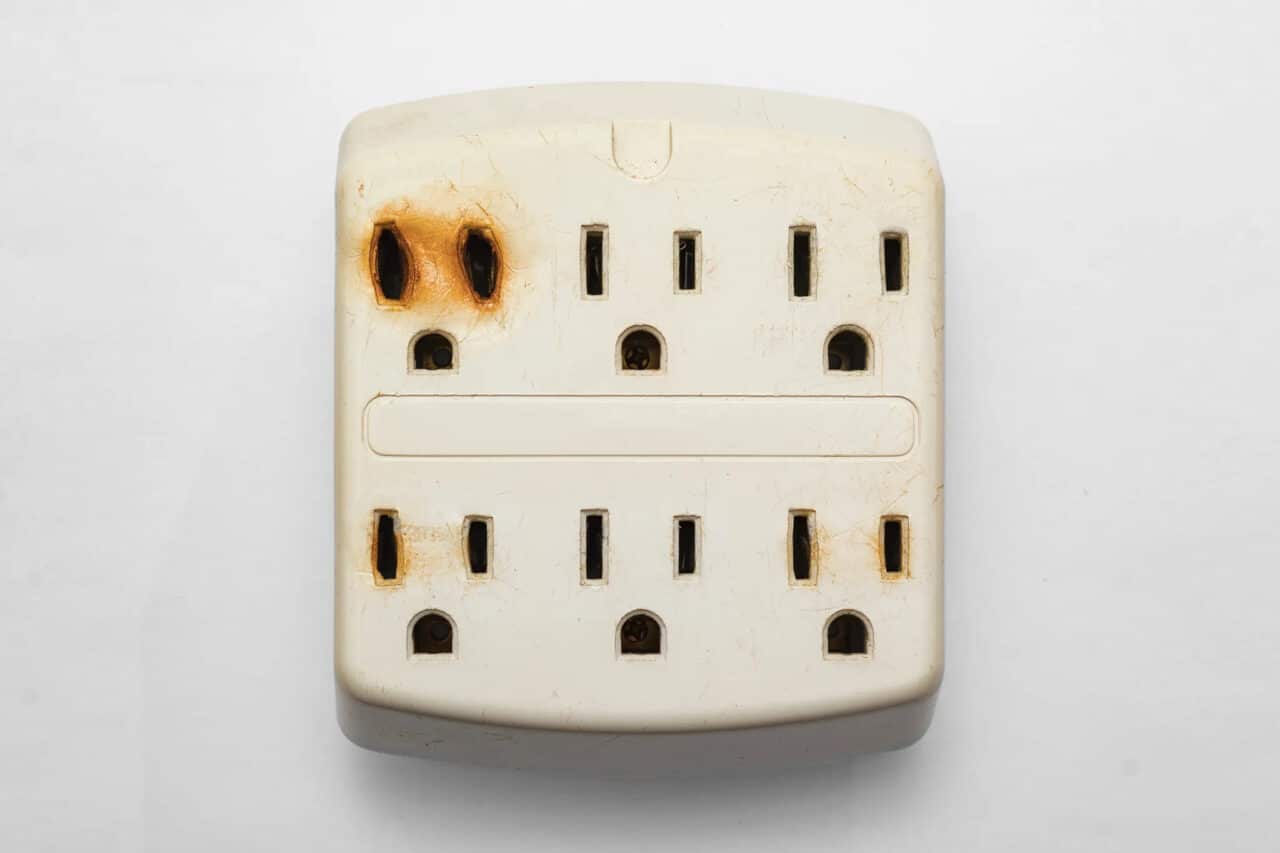That warm plug in your hand is probably nothing, right? In 2021 alone, more than 24,000 homes learned the hard way when electrical fires caused nearly 300 deaths and racked up $1.2 billion in property damage. Sure, electrical safety might be exciting, but trust us, you want to get this right.
So, is it dangerous if a plug gets warm, or are you worrying over nothing? We’ve been keeping homeowners safe and informed about electricity since 1944, serving families across Tennessee, Alabama, Kentucky, and Georgia. And in this blog, we’ll set the record straight.
Why Do Plugs Get Warm?
You’re probably already picturing smoke alarms beeping, firefighters at the front door, or insurance paperwork piling up. But before you spiral, let’s get clear on what’s normal warmth and what could be trouble.
Normal Electrical Resistance
First off, some warmth from plugs is completely normal. Every electrical current encounters a little resistance. As electricity flows through a conductor, the material naturally opposes the flow to some extent, causing a small amount of heat to generate.
Low-level heat is typical, especially when charging your phone or laptop overnight or using smaller devices like bedside lamps, Bluetooth speakers, curling irons, hair dryers, and steamers for clothes.
Does that mean your lamp plug feeling mildly warm at midnight should send you sprinting for a fire extinguisher? Probably not. Mild heat isn’t automatically a hot plug emergency.
But keep your guard up. There’s a thin line between comfortably warm and dangerously hot.
High-Power Consumption Devices
Bigger, power-hungry devices demand more electricity and generate more heat in the process. We’re talking heavy hitters like air conditioners during our Southern summers and refrigerators humming 24/7. These types of appliances naturally warm plugs simply because they’re pulling substantial electrical loads.
With that in mind, nearly 20% of all consumer-product electrocutions each year involve large appliances, according to the U.S. Consumer Product Safety Commission. That’s not a number to ignore.
Check how hot your outlets feel while large appliances are running so you can be aware of any big temperature swings.
Loose Connections and Faulty Wiring
Old houses have charm, but they also have secrets hiding behind the drywall. One of those dirty little secrets is faulty wiring.
When wiring connections are loose or worn out, electricity arcs unpredictably, creating intense heat. You can’t see it, but you might smell a sharp, burning, plastic odor.
Here’s something that’ll sober you up quickly: electrical wiring causes twice as many house fires as faulty appliances. Think about that the next time you dismiss a flickering light or ignore that hot outlet behind the couch. Is saving a few bucks by ignoring maintenance worth that gamble?
Overloaded Circuits
We’ve all overloaded an outlet at some point: TV, laptop charger, video game console, and phone chargers stacked on a single plug … seem harmless until they’re not. Overloaded circuits push wiring and plugs to their absolute limits, raising heat levels quickly. An example of this includes dimmers on your lights. If a dimmer is in use and is too hot to the touch, an overloaded circuit could be the root cause.
Overloaded circuits, cords, and plugs are frequent culprits behind residential electrical fires. How much can you keep plugging in before things go sideways? Let’s not test fate, shall we?
Aging or Damaged Electrical Components
Your cords and plugs are like car tires. Eventually, they wear out, revealing cracks, frays, or completely exposed wires. In our humid Southeast climate, deterioration can accelerate quickly.
Yes, it’s one more thing on your homeowner’s to-do list. But a quick inspection of your cords, plugs, and outlets now beats an electrical fire later.
So, is it dangerous if a plug gets warm? Warm plugs aren’t always dangerous, but they aren’t always harmless either. Knowing the difference between everyday warmth and serious overheating helps you stay safe, protect your family, and sleep soundly at night.
Warning Signs of an Overheating Plug
Overheating plugs aren’t shy about giving you clues, but far too many homeowners ignore those hints until the damage is done. Electrical issues rarely fix themselves. So, how do you spot a hot plug or outlet problem before you’re standing in your yard at midnight, watching firefighters roll hoses across your lawn?
Here’s exactly what to watch for:
- Plugs that become too hot to touch comfortably
- Burn marks, discoloration, or melted plastic around outlets
- Burning smells coming from outlets or devices
- Frequent circuit breaker trips
- Flickering or dimming lights and inconsistent electrical flow
If you’re seeing one of these signs, or multiple symptoms stacking up, it’s time to figure out exactly how to stop a plug from overheating. We offer professional electrical inspections throughout Tennessee, Alabama, Kentucky, and Georgia so you can find the issue fast and fix it before it becomes serious. Or just scroll on to the next section …
How to Stop a Plug from Overheating
You don’t have to cross your fingers and hope for the best. You can stop a hot plug from becoming a full-blown hazard with a few simple, proactive steps. Here’s how to stay one step ahead without waiting for a burning smell to tell you it’s time.
Check Cords and Outlets for Damage
Over time, cords can dry out, split, or fray, especially in older homes or high-humidity areas like the Southeast. When you’ve got cracked insulation or visible wires, electricity can arc and start cooking the plug from the inside. Outlets can also be a problem. Loose connections, worn-out contacts, or hidden scorch marks behind the faceplate can all lead to a hot outlet or even a house fire.
Once a month, take two minutes and scan your outlets and cords. Look for:
- Discoloration or dark smudges around the socket
- Bent prongs
- Exposed wires or cracking insulation
- Plugs that wiggle when inserted
Don’t wait for a “zap” to confirm your suspicions. Fix or replace damaged components quickly.
Keep Plugs Firmly in the Outlet
You know that one outlet where everything feels a little loose? Where the phone charger keeps falling out, no matter how gently or forcefully you plug it in? That’s cause for concern.
Loose plugs don’t make full contact with the outlet, which forces electricity to jump tiny gaps. That’s how arcing happens. Arcing = sparks. Sparks = heat. Heat = house fire.
If the plug doesn’t stay snug or slips halfway out, stop using the outlet and replace it immediately.
Avoid Overloading Circuits
Your outlets aren’t designed to power a full-blown entertainment center, space heater, and air fryer all at once. Most standard household circuits are rated for either 15 or 20 amps. When the total demand from your devices exceeds that limit, the wiring overheats.
Even if your breaker doesn’t immediately trip, consistent overloading weakens electrical components over time and increases fire risk.
If your breakers are frequently tripping or your lights dim when appliances kick on, your system is overloaded. Be smart and spread devices out. Limit high-wattage appliances to one per outlet to prevent strain and stop overheating before it starts.
Use Surge Protectors and Heavy-Duty Cords
There’s a reason those cheap, flimsy extension cords sell for a few bucks at the dollar store. It’s because they’re barely safe enough to trust with your Christmas lights, let alone appliances pulling serious power.
Use heavy-duty, grounded extension cords for high-draw devices. Better yet, professional installation of dedicated circuits and outlets for major appliances is recommended.
When in doubt, invest in a surge protector. During thunderstorms, as we get here in the South, lightning strikes can send sudden, powerful voltage spikes through your wiring, frying sensitive electronics and appliances in an instant. Surge protectors absorb that spike, keeping your devices and appliances safe.
Schedule Annual Electrical Inspections
When was the last time you had an electrician walk through your home just to check your wiring and outlets?
Yes, you’re busy. We all are. Scheduling an annual electrical inspection can feel like a hassle or another expense to add to homeownership until you remember what’s at stake: Your family’s safety, your irreplaceable belongings, your peace of mind …
Regular inspections from a professional electrician can catch and solve small problems, helping you stay ahead of any potentially dangerous situations.
Staying safe takes effort, but it’s a small price to pay compared to standing in front of a burned-out home.
When to Call an Electrician
Not every electrical issue can or should be handled with a DIY fix. There’s a reason electricians go through years of classroom training, hands-on apprenticeships, and rigorous licensing exams. And it doesn’t stop after certification. Reputable companies stay insured, follow strict safety codes, and keep up with changing regulations.
So, when do you stop Googling and start dialing a professional?
Ask yourself:
- Is your home still running on original wiring from decades ago?
- Are your outlets missing grounding holes or feeling loose?
- Do your lights flicker or dim without warning?
- Have you added new appliances without upgrading your electrical panel?
- Are extension cords filling in where permanent outlets should be?
- Do you hear buzzing, popping, or crackling near outlets or switches?
- Have you ever smelled something burning but couldn’t find the source?
- Are your breakers tripping regularly or refusing to trip at all?
- Is there discoloration, heat, or scorch marks on any outlets or plugs?
If you nodded “yes” to any of those (or even hesitated), it’s time to bring in a licensed electrician. A professional can spot the hidden problems you can’t see before they become dangerous.
Protect Your Home with Professional Electrical Services
If something feels off, it probably is. And when it comes to electricity, guessing wrong isn’t worth the risk.
We’ve been keeping homes across Tennessee, Alabama, Kentucky, and Georgia safe since 1944. Our licensed, insured electricians know exactly what to look for and how to fix it before it turns into a fire, outage, or fried appliance. Whether it’s an emergency repair, a whole-house rewiring job, or just peace of mind with a routine inspection, we’ve got you covered.
Ready to stop guessing and get it handled? Schedule your service today.
Concerned about a warm plug?
CALL US NOW AT 615.567.1000

